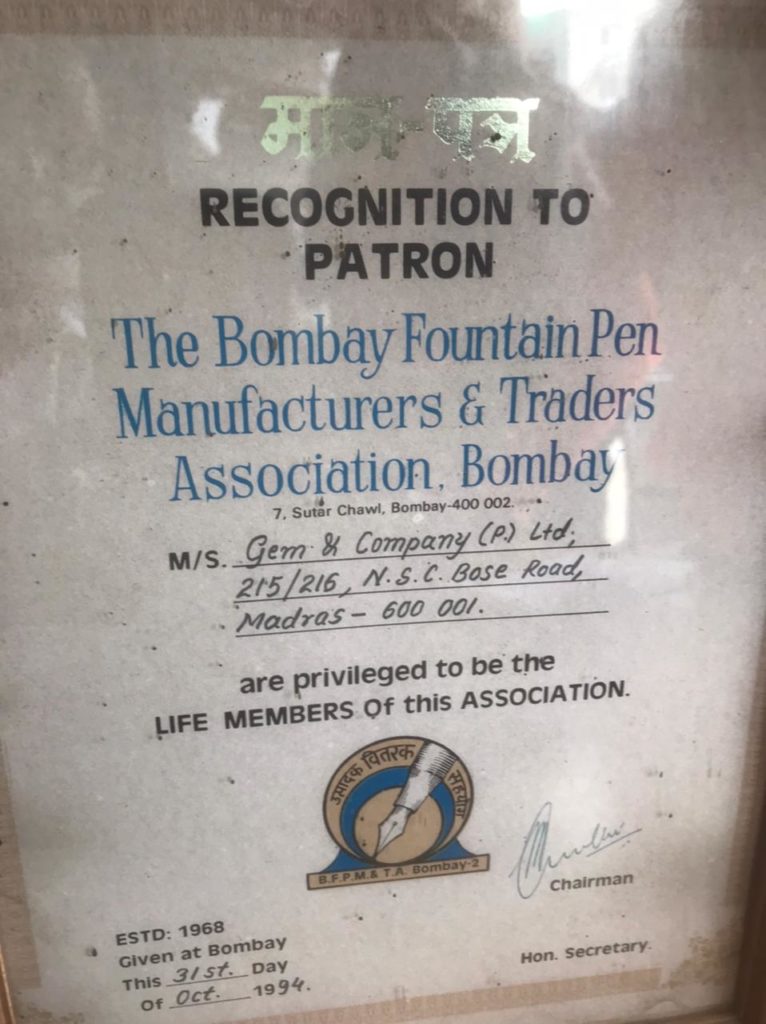Indian Fountain pens are my dope. The never cease to give me a high. Especially if they are of a certain vintage, hand turned, eye-dropper fillers, made of ebonite and sport pure, “desi” nibs. The ones that give me mind-altering experiences are naturally the type that immediately transport me to a different time zone, to a period when the particular pen was in its infancy, letting me observe the lives and times of its past owners, our ancestors. I peep into classics being created, important events that will shape destinies unfolding, or merely common people going about their chores – keeping records, penning love letters, drawing up lists, preparing for examinations – doing ordinary, everyday things. For, a fountain pen, to me at least, is not just a mere instrument that one uses to write with. It is a lot more. It has always been a chronicler of the times, and if it gets to trust you, it not only yields to you physically, but also opens up emotionally, baring its soul, transforming the experience into a spiritual, even ethereal one. Admittedly such pens in good working conditions are hard to come by.
The next best alternative is to acquire an Indian, hand-turned, ED filler, ebonite pen. The market is awash with fountain pens that adorn themselves with the above complements, that too in almost all the price points. What most such pens lack is the lineage, the legacy of the turner, the pen-turning genetic instructions embedded in the DNA of the maker, which immediately disqualifies nine out of ten to make the leap from counter to my pocket, enroute to my heart. I say this because I find that there are two types of fountain pen makers. One, and they are the overwhelming majority, to whom pen making in a business. If they were not making pens, they would perhaps be raising chicks in a poultry, or taking up data entry jobs, or running a STD/ISD/ Xerox outlet like many of them were before they realised that monies can be made by liquidating the old stock of pens left from the time when their ancestors were in the business, becoming “reputed penmakers”, the flag-bearers of Indian penmaking overnight.
The second type, and they are a rare breed indeed, comprise of ones who have been turning pens for generations; had stuck to the calling when the going was extremely tough for fountainpen makers a couple of decades back; and continue to turn fountain pens as there is nothing else that they would willingly do. Yes, they love their pens. Perhaps a lot more than you and I love the pens that we acquire from them and continue to be treasure troves of memories of pens past. That they make pens that defy time goes without saying.
My go-to establishment for acquiring such classics is Gem & Co, makers of the Gama brand of pens in Chennai and the raconteur to meet is Pratap Kumar. Now, the establishment is nearly a hundred years young and Pratap Kumar has been tuning the pens of the big and the mighty including film stars, industrialists, academicians and Chief Ministers for longer than he cares to remember. But talk to him and he will come across as an extremely humble person, one whose life revolves around his passion, the fountain pen. His knowledge about his pens impeccable. His love for the art, peerless.
I have not been fortunate enough to meet Pratap Kumar in person, or of making the pilgrimage to the sacred shrine where he is the reigning deity, though I have partaken of his “prasadam” in the form of the pens created by him many times over. The process is generally facilitated by our common friend Prof Janardhan who is not only a walking encyclopedia on all things writing and writing instruments, but also speaks the native tongue. Thus, when Prof Janardhan informed me about his plan to visit Chennai and the probability that he would visit Gem & Co as well, the first thing that I had requested him was to get the pens that he liked for me. The rarer the better.
To cut a long story short, he did get me a handful of pens from the trip and I am showcasing only three of them here because of the simple reason that the hues of the ebonites used to make these pens are extremely close to my heart. I will not bother the readers by saying just how well these pens are made or how beautiful the craftsmanship is or even commenting on their user-friendliness – I have written extensively about Gama pens in the past and do not wish to burden the readers with the same platitudes. Yes, each one is a remarkable pen, capable of being the one pen that one could acquire if one were looking for only one writing instrument for the rest of one’s life.
But what is even more exciting are the stories one gets to hear from the master, no less. Take for example the stories about the Associations of Fountain Pen Manufacturers in Chennai and Mumbai, where Gem & Co was a member? Pratap Kumar talks fondly about them, especially the one in Chennai, which was instrumental in taking a delegation of manufacturers to meet the Chief Minister of the state which had led in turn, to a reduction in the taxes, which to a great extent was responsible for the popularity of fountain pens for many years that had followed. Wouldn’t it be interesting to know whether these organisations are still functional? Perhaps they too have survived the onslaught of the use-and-throw monstrosities and the digital tsunami and are waiting to be revived? Imagine the kind of tales they can tell – especially about those golden days of the fountain pen and ink, of the larger-than-life men and women wielding them, the challenges of manufacturing and sales that they faced and the ways they had devised to overcome them? Why just tales? Imagine the banquet of information about the industry, the sheer richness of experience that future generations can dig into? Time we had another long chat with Pratap Kumar.
Check the video: #Gama #Ebonite #FountainPens, anyone?
https://www.youtube.com/watch?v=XqoBtgQ21wI

